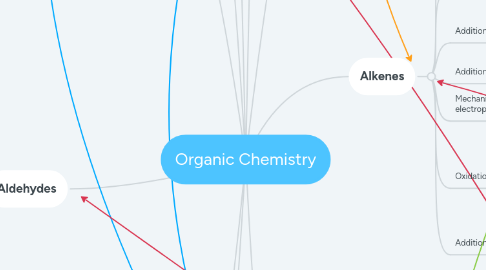
1. Carboxylic Acids
1.1. Preparation
1.1.1. From nitriles
1.1.1.1. Reflux with dilute HCl
1.1.1.2. Hydrolysis
1.1.1.3. CH3CH2CN + HCl + 2H2O → CH3CH2COOH + NH4Cl
1.2. Reacting as acids
1.2.1. Weak acid
1.2.1.1. Do not dissociate completely
1.2.1.2. CH3COOH ⟺ CH3COO- + H+
1.3. Reduction
1.3.1. Tetrahydridoaluminate,LiAlH4 in dry ether
1.3.1.1. Reacts violently with water
1.3.2. Sodium borohydride,NaBH4
1.3.3. Alcohol
1.3.3.1. CH3COOH + 4[H] → CH3CH2OH + H2O
1.4. Heated under reflux with strong acid catalyst, conc H2SO4
2. Aldehydes
2.1. Preparation
2.1.1. Primary alcohol
2.1.2. Acidified potassium dichromate (VI)
2.1.3. Heated gently
2.1.4. CH3CH2CH2OH + [O] → CH3CH2CHO + H2O
2.1.5. Orange → Green
2.1.6. Aldehyde need to be distilled off as soon as it is formed to prevent further heating which produces carboxylic acid
2.2. Reduction
2.2.1. Primary alchohol
2.2.2. LiAlH4 in dry ether
2.2.3. Aqueous NaBH4
2.2.4. CH3CHO + 2[H] → CH3CH2OH
2.3. Nucleophilic addition with HCN
2.3.1. Nitriles
2.3.2. CH3CH2CHO + HCN → CH3CH2CH(OH)CN
2.3.3. Mechanism
3. Ketones
3.1. Preparation
3.1.1. Secondary alcohol
3.1.2. Acidified potassium dichromate (VI)
3.1.3. Heated
3.1.4. CH3CH(OH)CH3 + [O] → CH3COCH3 + H2O
3.1.5. Do not further oxidise, do not distil out
3.2. Reduction
3.2.1. Secondary alcohol
3.2.2. LiAlH4 in dry ether
3.2.3. Aqueous NaBH4
3.2.4. CH3COCH3 + 2[H] → CH3CH(OH)CH3
3.3. Nucleophilic addition with HCN
3.3.1. Nitriles
3.3.2. CH3COCH3 + HCN → CH3C(OH)CH3CN
3.3.3. Mechanism
4. Esters
4.1. Esterification
4.1.1. Reversible
4.1.2. Sweet & fruity smell
4.1.3. Flavourings,perfumes,solvents
4.1.4. C2H5OH + CH3COOH → CH3COOC2H5 + H2O
4.1.5. First part : Alcohol Second part : Carboxylic acid
4.2. Hydrolysis
4.2.1. Reflux with acid/base
4.2.1.1. 1. Acid
4.2.1.1.1. Alcohol + Carboxylic acid
4.2.1.1.2. Reversible
4.2.1.1.3. CH3COOC2H5 + H2O ⟺ CH3COOH + CH3CH2OH
4.2.1.2. 2. Alkali
4.2.1.2.1. Soluble base, NaOH (aq)
4.2.1.2.2. Not reversible
4.2.1.2.3. Alcohol + Sodium salt of COOH
4.2.1.2.4. CH3COOCH2CH3 + NaOH → CH3COO-Na+ + CH3CH2OH
5. Nitriles
5.1. Hydrolysis
5.1.1. Carboxylic acid
5.1.2. Reflux with dilute HCl
5.1.3. -CN + H+ + H2O → -COOH + NH4+
5.2. Reduction
5.2.1. Amine
5.2.2. Sodium and ethanol
5.2.3. -CN + 4[H] → -CH2NH2
6. Test for Aldehydes & Ketones
6.1. 2,4-dinitrophenylhydrazine (2,4-DNPH)
6.1.1. Orange precipitate
6.2. Tollens' Reagent
6.2.1. Aqueous AgNO3 in excess NH4 solution (Ammoniacal Silver Nitrate solution)
6.2.2. Mild oxidising agent
6.2.3. Ag+ oxidise an aldehyde to form carboxylate ion
6.2.4. Aldehydes : Silver mirror
6.2.5. Ketones : No reaction
6.3. Fehlings'/Benedict's solution
6.3.1. Copper (II) ions as oxidising agent
6.3.2. Aldehyde oxidised to carboxylate ion & Cu2+ → Cu+
6.3.3. Aldehydes : Clear blue → brick red precipitate
6.3.4. Ketones : No reaction
7. Alkanes
7.1. Combustion
7.1.1. Complete
7.1.1.1. CO2+H2O
7.1.2. Incomplete
7.1.2.1. C/CO+H2O
7.2. Free Radical Substitution
7.2.1. UV light/Sunlight
7.2.1.1. Halogenoalkanes
7.2.1.2. CH4+Cl2 → CH3Cl + HCl
7.3. Cracking
7.3.1. Alkene + Alkane
8. Alkenes
8.1. Addition of hydrogen, H2
8.1.1. Nickel,140°C
8.1.1.1. Alkane
8.1.1.2. C2H4 + H2 → C2H6
8.2. Addition of steam, H2O
8.2.1. Concentrated H3PO4,330°C,6MPa
8.2.1.1. Alcohol
8.2.1.2. C2H4 + H2O → C2H5OH
8.3. Addition of hydrogen halides, HX (aq)
8.3.1. HF,HCl,HBr,HI,room temperature
8.3.1.1. Halogenoalkanes
8.3.1.2. C2H4 + HBr → C2H4Br
8.4. Addition of halogens, X2 (aq)
8.4.1. Decolourise
8.5. Mechanism of electrophilic addition
8.6. Oxidation of alkenes
8.6.1. Acidified potassium manganate (VII)
8.6.1.1. Cold dilute KMnO4
8.6.1.1.1. Purple solution turns colourless
8.6.1.2. Hot concentrated KMnO4
8.6.1.2.1. Ketones/Aldehydes/Carboxylic Acids/CO2+H2O
8.7. Addition polymerisation
9. Halogenoalkanes
9.1. Nucleophilic substitution reaction
9.1.1. 1. Aqueous alkali, OH-
9.1.1.1. Alcohol
9.1.1.2. C2H5Br + NaOH → C2H5OH + NaBr
9.1.2. 2. Potassium cyanide,KCN in ethanol (ethanolic)
9.1.2.1. Heat under reflux
9.1.2.1.1. Nitriles
9.1.2.1.2. C2H5Br + KCN → C2H5CN + KBr
9.1.3. 3. Ammonia,NH3 in ethanol
9.1.3.1. Dissolved in ethanol under pressure
9.1.3.1.1. Amines
9.1.3.1.2. C2H5Br + NH3 → C2H5NH2 + HBr
9.2. Elimination reaction
9.2.1. NaOH (Ethanolic)
9.2.1.1. Alkene
9.2.1.2. CH3CHBrCH3 + NaOH → CH2CHCH3 + H2O + NaBr
9.3. Hydrolysis
9.3.1. Heat under reflux : React without evaporating the volatile organic compound
9.3.1.1. Alcohol
9.3.1.2. CH3CH2Br + H2O → CH3CH2OH + HBr
9.4. Mechanism of nucleophilic substitution
9.4.1. 1. Primary halogenoalkanes,SN2
9.4.2. 2. Tertiary halogenoalkanes,SN1
10. Alcohols
10.1. Combustion
10.1.1. CO2+H2O
10.1.2. C2H5OH + 3O2 → 2CO2 + 3H2O
10.2. Substitution
10.2.1. Halogenoalkanes
10.2.1.1. 1. HX
10.2.1.1.1. CH3CH2OH + HCl → CH3CH2Cl + 3H2O
10.2.1.2. 2. SOCl2
10.2.1.2.1. C2H5OH + SOCl2 → C2H5Cl + HCl + SO2
10.2.1.3. 3. PCl5/PCl3
10.2.1.3.1. C2H5OH + PCl5 → C2H5Cl + HCl + POCl3
10.2.1.4. 4. PI3
10.2.1.4.1. 3C2H5OH + PI3 → 3C2H5I + H3PO3
10.3. Reaction with Na
10.3.1. Sodium alkoxide
10.3.2. C2H5OH + Na → C2H5O-Na+ +H2
10.4. Dehydration
10.4.1. Alcohol vapour passed through hot Al2O3 powder/porous pot/pumice
10.4.1.1. Alkene
10.4.1.2. C2H5OH → CH2CH2 + H2O
10.5. Oxidation
10.5.1. Potassium dichromate (VI),K2Cr2O7 acidified with H2SO4
10.5.1.1. 1. Primary alcohol
10.5.1.1.1. Aldehyde → Carboxylic acid
10.5.1.1.2. CH3CH2OH + [O] → CH3CHO + H2O
10.5.1.1.3. CH3CHO + [O] → CH3COOH
10.5.1.1.4. Orange → Green
10.5.1.2. 2. Secondary alcohol
10.5.1.2.1. Ketone
10.5.1.2.2. CH3CHOHCH3 + [O] → CH3COCH3 + H2O
10.5.1.2.3. Orange → Green
10.5.1.3. 3. Tertiary alcohol
10.5.1.3.1. Remains orange, no reaction
10.5.2. Solution warmed
10.5.3. Distinguish primary,secondary & tertiary alcohol
